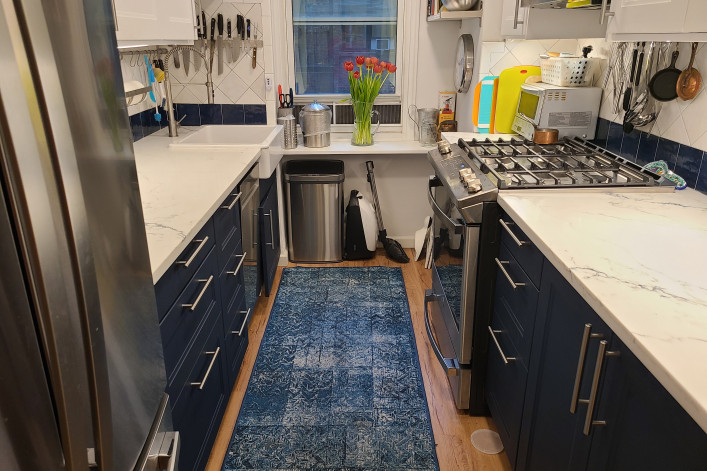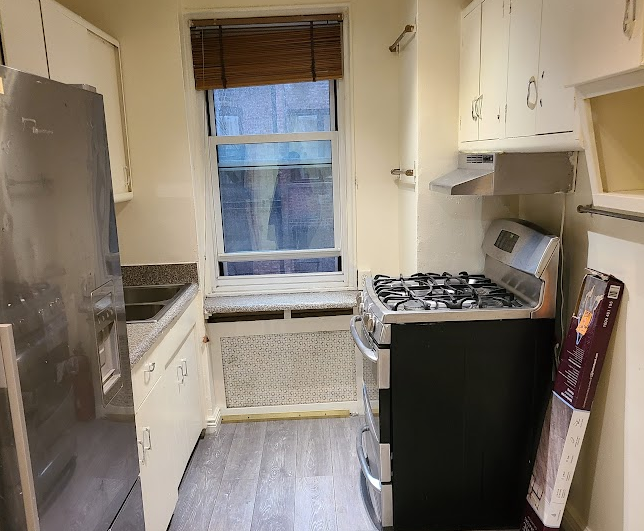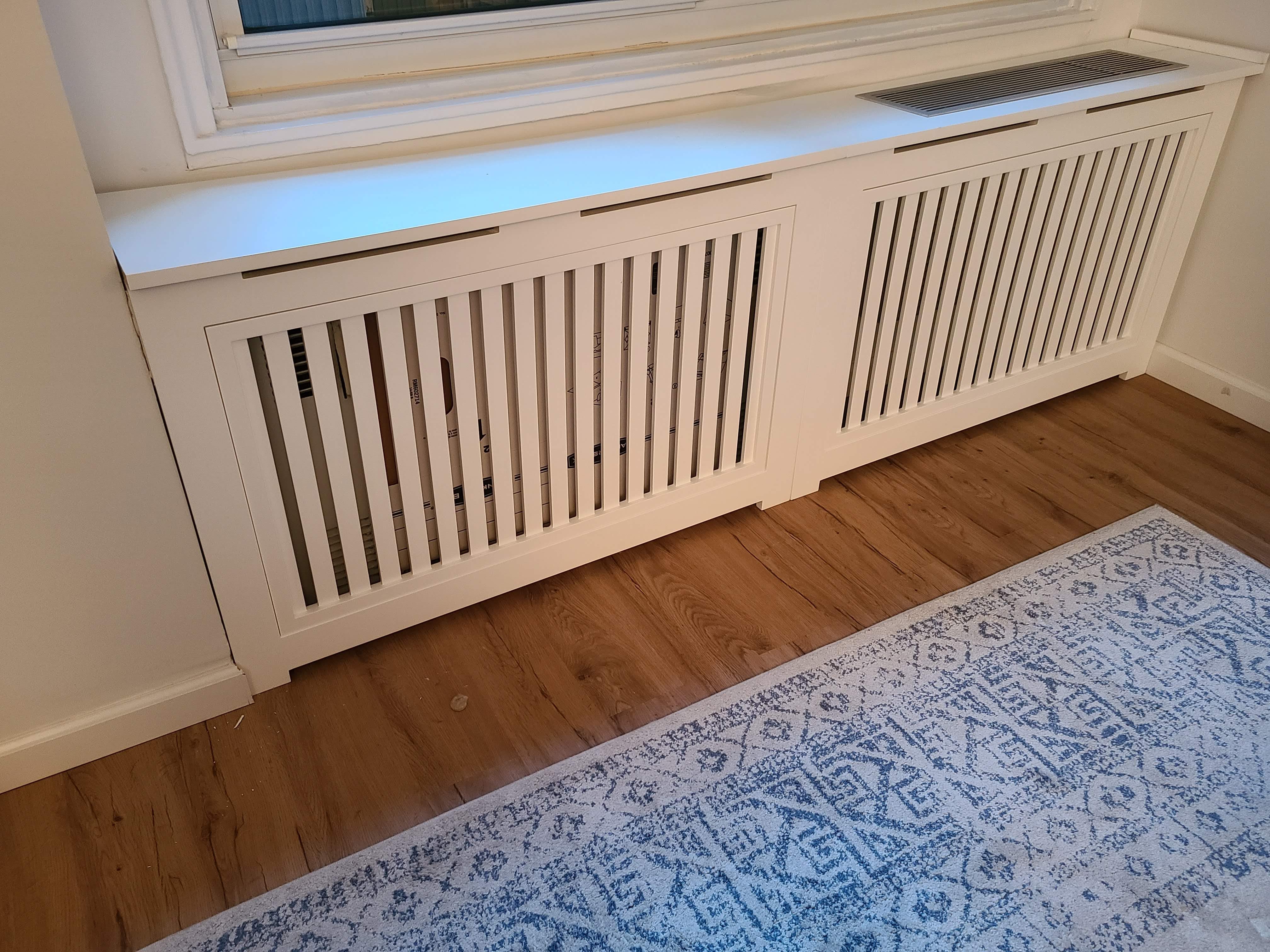When it’s OK to say ‘thanks but no thanks’ to your contractor
- A long-time New Yorker explains how she held her ground during a co-op renovation

The author wanted white countertops with a blue vein—and that's what she got after tracked down the stone herself.
Photo by Mary Lowengard
Years ago, when I renovated my newly purchased, sorely neglected Manhattan co-op, it didn’t occur to me that I should hire a general contractor to manage and oversee the project. Instead I asked the super for references and he handed me some business cards. And that’s how I hired an electrician and plumber.
I managed it all by myself, and while it wasn’t easy, I learned “on the job.”
I had IKEA create a slick new kitchen and the designer recommended a team to install it. I found the name of a tiler for the backsplash on a bulletin board at the tile store. I called on the services of a flooring installer recommended by the carpet and flooring store to lay down carpeting and Pergo in the kitchen. My three kids (ages four, five and six at the time) learned to love our outings to the now long-defunct Topps Appliance City. I asked a painter I knew from New Jersey to take over the wall décor and voila! I had a renovated apartment.
So when it was time to do it all again, this time a renovation of a one-bedroom estate-condition apartment that my daughter and her husband bought across the hall from my original apartment, age and wisdom motivated me to hire a general contractor to manage the project. Time was of the essence: My daughter was six-months pregnant. The plan was to swap apartments once the baby arrived. They’d take over my three bedroom and I’d downsize into the one-bedroom. And I’d be a contender for the Grannie of the Year Award for my efforts!
I auditioned three candidates recommended by the super and handed the rose to Mr. V. based on his project estimates and favorable recommendations from neighbors. The fact that he had several projects underway in the building seemed to indicate he wouldn’t disappear to greener projects. He was also the most charming of the three candidates.
Mr. V. supervised the installation of new flooring, reconfiguring closets, creating a dining area, repairing, skim coating and painting the walls and creating a magnificent if not-quite spa-like bathroom with a walk-in shower to replace the old bathtub.
I have no regrets about the work accomplished, but I did realize early on that I could—and should—take responsibility to make sure things turned out the way I wanted them to. I learned a critical lesson. Even if you think your contractor walks on water, even if he’s full of good ideas and experience from his years of renovation management, there will be times when you just gotta say no—and it’s OK.
Here’s a punch list of how many times I said “no” that you can use to trust your gut during your own renovation.

My first big 'no': the kitchen
I knew I wanted to use IKEA’s design services for this project. IKEA had never disappointed me when I renovated my original co-op and its 2020 update. Kitchen renovations are often the priciest part of a renovation; they involve many workers and hefty contractor fees. Early in our negotiations I had to break it to Mr. V. that his team should stay out of my kitchen and he should leave cabinet installation out of his pricing estimates.
Initially, he scoffed at the notion, but when I showed him the specs IKEA provided, he confessed he couldn’t compete on cost or improve the design. We exchanged testy words about the quality of their materials. Happily, it wasn’t a deal breaker. And the multitude of issues with IKEA—including huge delivery delays due to a warehouse fire—thankfully weren’t “I told you so” moments. We muddled on through.
Mr. V. did offer some input into the kitchen design. He urged me several times to get a full-size dishwasher instead of the 18-inch “apartment size” model I wanted. “You won’t be happy,” he said. But the smaller machine would allow more cabinet space in the not-quite 8-by-11 foot kitchen and this was the right decision. So, I’m glad I went with my own instinct and ignored his advice.
Countering the countertop offer
I did ask Mr. V. if his team could provide the electrical work and plumbing set up for the kitchen, as his electrician and plumber were working on other projects in the apartment—the wiring within the walls and the bathroom shower. And I asked for his help with the countertop and backsplash tiling.
Mr. V. offered to introduce me to a fabricator; I could pay him directly for the countertop, thus avoiding the contractor markup. The fabricator is the special guy who shows up at your place to take precise measurements for your countertop, then cuts and installs it.
Mr. V.’s fabricator arrived and did his measuring thing. It was then I learned his “thing” did not include sourcing and purchasing the countertop material on my behalf. I was on my own to find and deliver the countertop stone to his workshop.
The fabricator referred me to a yard in Long Island City. I visited, but I was disappointed by the offerings—and I would be required to buy an entire 12-foot slab even though I only needed a four-foot piece. So again, I said, ‘no thank you’ and set out to find my own countertop.
I thought I’d found the perfect stone countertop at a chain store. But then the quote for delivery came with a sizable add-on cost: $787.50. What was this? A “Manhattan trip charge” I was told. I was informed (when I demanded a breakdown) it covered “special handling when using elevators,” “parking for trucks,” “permit fees” of an unspecified nature, “labor to create an insurance rider,” and “commercial truck tolls and fees for entering the city each way.” I considered it an affront to spend this much, which was essentially a penalty tax on Manhattan living that did not come close to actual costs. When negotiations stalemated, I walked away from this option and demanded (and to the store’s credit, promptly received) my deposit money back.
Thus, I found myself trawling the internet for a supplier who would stock, fabricate, and install the countertop of my dreams. Late on a Friday afternoon, I landed on the website of a stone yard that seemed promising. The next morning I found myself in Roselle, NJ checking out the inventory at GraniteTops. The countertop I wanted—white quartz with blue veining—was almost the first piece I saw. On Monday they came to measure. On Thursday they returned and installed the countertop. No add-on tax for living in Manhattan levied.
A knobby dilemma
Meanwhile, I was again holding my ground against Mr. V., this time on a superficial issue. I had ordered handsome doorknobs from Wayfair to be installed throughout the apartment. Inspecting them on their arrival, Mr. V. claimed that I hadn’t ordered the correct type and wanted me to return them. The issue? He said I needed locking knobs for the bedroom and the bathroom doors.
No, I told him, this one-bedroom apartment was slated for a single tenant—me—and I didn’t need locks on my interior doors. As I saw it, the only person who would get locked out was me. He insisted. So did I. Finally, Mr. V. relented (isn’t the customer always right?) and installed the lockless doorknobs throughout. They are just fine.

The final straw
My final “no” was to a subcontractor that Mr. V. brought in to design and fabricate wood radiator covers for the living room, kitchen and bedroom. This was another item which we agreed I would pay for myself, outside the contract for his work, with no markup.
The millworker came in and examined the three areas. A few weeks later I received the estimate: $14,500. Seriously? That was more than double my first year’s salary teaching at a posh private school. Even Mr. V. agreed it was out of line, theorizing that the millworker was probably particularly busy and was perhaps trying to scare me off. He offered to introduce me to a second millworker who he promised would be more reasonable.
Several weeks passed before millworker number two arrived to take measurements and discuss options. By then I’d decided not to install a cover in the kitchen, that a $35 piece of melamine installed under the window would suffice. So now I only needed two radiator covers.
The second estimate came in significantly lower, at $8,400, but still above the Posh Private School Salary Benchmark. Too much. Once again, I turned to the Internet and quickly discovered an online company, Fichman Furniture that, for a fraction of those prices, would fashion a radiator cover with an inset grill and pop-out panels. I ordered one as a test, brought in a TaskRabbit to install it and voila! I had exactly what I wanted at a PPSSB-friendly price of $1,500. I promptly ordered a cover for the bedroom radiator and invited the same TaskRabbit for a return visit.
The covers look great and work perfectly. I am very glad to have just said no to the contractor’s options.
Lessons learned
The three keys to a productive relationship with your contractor are communication, communication and communication. I had absolutely no beef with the quality of the work Mr. V’s team did, and a missed deadline or two here and there didn’t turn out to be too disastrous. His budget remained reasonable right up to the end. Best of all, he was willing to let me just say no.
Mary Lowengard is a writer and editor who has been in a New York State of mind since 1971. She recently published a collection of essays about owning and fixing up a country house, “The Bucknoll Cottage Chronicles: Sex and the City meets Under the Tuscan Sun, but no sex, no city and in the Poconos." The title says it all.























